
WELCOME TO WEEK THREE of 21 Nights of Giallo! Over the past 14 nights of reviews, I covered movies from Dario Argento, Mario Bava, Lucio Fulci, Luciano Ercoli, Sergio Martino and more. I’ve been reviewing a classic Italian giallo film every night this month, as a fun lead-up to the March 22nd release of my 13th novel Five Deaths For Seven Songbirds. I love giallo films, and my novel is a homage to them… so I hope gialli fans will give it a look. You can read the first two weeks of film reviews in the blog entries 21 Nights of Giallo: Week One and Week Two. For our final seven nights, I’ll review films from Umberto Lenzi, Emilio Miraglia, Andrea Bianchi and more.
Here are the films for our final week:
NIGHT #21:
All The Colors of the Dark
Directed by Sergio Martino
Screenplay by Ernesto Gastaldi and Sauro Scavolini
Music by Bruno Nicolai
(1976)
For the final night of 21 NIGHTS OF GIALLO, I picked one of my all-time favorites. Featuring the always evocative Edwige Fenech at her most alluring, this one is directed by Sergio Martino and written by Ernesto Gastaldi – two of my absolute idols from the Italian giallo era. I have to say, I was incredibly excited when both of these men agreed to provide blurbs for my novel Five Deaths for Seven Songbirds. Having them say nice things about my personal giallo project was like… having a Stephen King blurb on your horror book.
So what’s this classic film about? Like last night’s Red Queen review, this one mixes in a supernatural element with the core giallo plot. Martino plays up the Rosemary’s Baby angle on this, so that for much of the runtime you might think you were watching a straight-on devil worship-themed horror film.
Giallo superstar Edwige Fenech plays Jane, a woman tortured by wild, chaotic dreams. The film starts with these fractured images, including a crazy looking wigged woman with silver teeth and bloody nude women on beds, one with an enormous pregnant belly. When Jane wakes from this nightmare and goes into the shower still in her nightshirt, her live-in boyfriend Richard (played by another giallo heavyweight, George Hilton (My Dear Killer, The Case of the Bloody Iris) walks in and proclaims, “you didn’t take your pills again.”
They eventually make love but she interrupts the proceedings when she has a vision of a man with a knife.
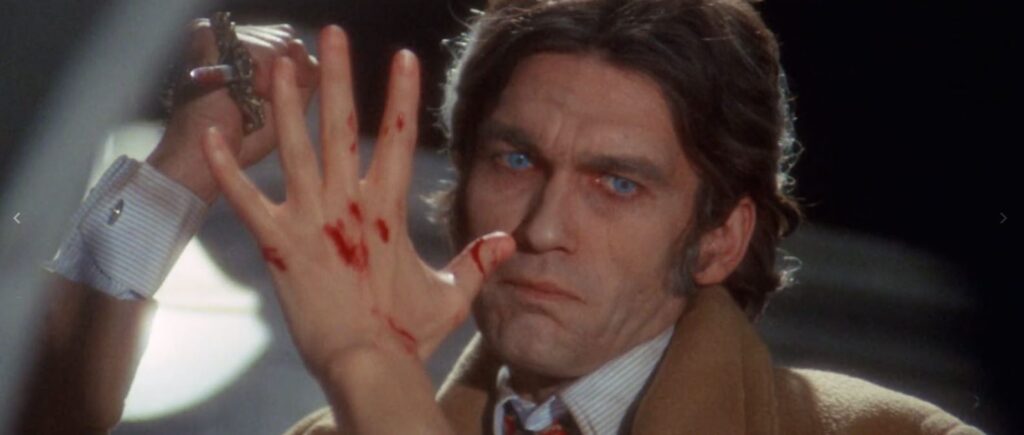
Turns out, Jane is dealing with the trauma of having seen her mother murdered as a girl and has recently had a miscarriage after a car accident caused by Richard. Her sister Barbara (Susan Scott, Death Walks at Midnight) encourages her to go to therapy with Dr. Burton, the kind old psychiatrist Barbara works for. She eventually does, but is spooked by a man she seems to keep seeing with piercing blue eyes sitting in the lobby. This man (played with perfect sinister mystery by Ivan Rassimov, The Strange Vice of Mrs. Wardh) will keep reappearing, with great tension-building scenes set in a beautiful British park and on an empty train car where the lights keep flickering on and off.

Things take a decidedly stranger turn when she befriends a new neighbor, Mary (Marina Malfatti, The Red Queen Kills Seven Times). We’ve previously seen her before watching Richard from a window in the building. When Jane arrives frightened to death at Mary’s apartment after escaping the blue-eyed stalker, Mary says, “you remind me of a lost child” and recommends that Jane join her at a Sabat. Because… well, Black Masses always help people get over their problems, right?
It’s a bit of a leap, but Jane really likes Mary and goes along with it, which makes for some great creepy weird-lensed scenes to follow, as she joins the Sabat at a great gothic mansion in a ceremony where they drink animal blood. “Drink this and you will be free,” the leader promises… and then he rips off her dress and proceeds to make love to her with the participation of the rest of the mob.
Those crazy, sexy ‘70s!
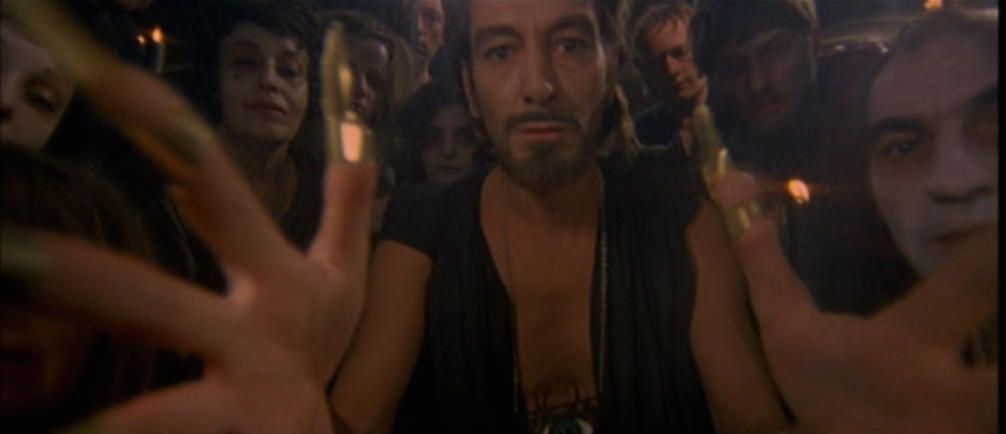
There are some great psychedelic camera shots and wild soundtrack music as Jane succumbs to the cult … and then she’s suddenly back at home with Richard, and looking at herself in a cool shot in a three-way mirror. As if trying to see what has happened to her.

When she finds a book on Magic and the Supernatural in Richard’s things, she begins to get suspicious, but still returns to the Sabat and “offers herself” once again. But then the leader presses a knife to her hands and says she must sacrifice one of their number and truly become one of them…
All the Colors of the Dark is a fever dream of a giallo, filled with erotic and frightening imagery, with great cinematography from its arty “nightfall” opening to its wild climax. There is one scene when Jane is taken by the doctor to a “safe house,” which ranks right up there with the best moments in horror, when Jane walks into the kitchen the morning after. There are lots of fun “dark” themed elements, including the “eye” tattoo that all the Satanic cult members have on their bodies… which helps, ultimately, to unravel the real deal of what’s going on here. All I’ll say is that there really is a giallo twist at the center of it all.
The wild visuals inspired a fabulous sometimes eerie, sometimes soothing, sometimes tense and throbbing soundtrack from the always great Bruno Nicolai. In the main theme, he uses a chorus of voices to suggest that “Satanic Mass” vibe, along with some quirky sitar, a mazelike bassline, and some “witchy howls” to create both a spooky and undeniably catchy theme. You can hear it here on YouTube.
If you are a fan of horror or giallo films, this should be in your collection. You can get a beautifully remastered edition of the film on DVD or Blu on Amazon from Severin Films.

10 out of 10 black-gloved fingers!
NIGHT #20:
The Red Queen Kills Seven Times
Directed by Emilio Miraglia
Screenplay by Miraglia and Fabio Pittorru
Music by Bruno Nicolai
(1972)
Emilio Miraglia directed two of my favorite giallo films, The Night Evelyn Came Out of the Grave (reviewed here) and The Red Queen Kills Seven Times, the final film in his short catalog (which also includes a couple of crime dramas and a spaghetti western). Both of his gialli bring in the idea that someone has come back from the dead to avenge their murder and oddly, both feature lead characters named Evelyn, though there is otherwise no connection between the films.
In The Red Queen Kills Seven Times, (also released in America as The Lady in Red Kills Seven Times) we’re introduced at the outset to two nine-year-old quarreling sisters, a blonde and a brunette, and their grandfather, who talks about the history behind a painting which depicts a brunette woman in red stabbing another… it seems that every hundred years, one sister in this house kills another, along with a half dozen others. And that curse is due to happen when the two sisters are young women, in 1972. We think we know exactly where this film is headed, when the young brunette proclaims “I’m the red queen” and stabs the doll with a dagger, cutting off its head.
Fast forward to 1972 and we quickly learn that the blonde sister, Kitty, has accidentally killed Evelyn, but her other sister and brother-in-law, Franziska and Herbert, have helped cover it up. They all say that Evelyn is away in America. Kitty’s wracked with guilt over this, but tries to keep a lid on it. But then… her grandfather is visited by a woman in a red cape and dies of a heart attack. And then his will is read, which says that an equal distribution of his estate will go to his heirs, but not until the “year of the curse” is past.
Kitty (Barbara Bouchet, Don’t Torture a Duckling) is a fashion model photographer who is also the mistress of an up-and-coming executive named Martin (Ugo Pagliai). But then Martin’s boss gets killed by a red-cloaked woman, earning him a promotion. And then his institutionalized schizophrenic wife is also killed (in a particularly clever, gruesome kill using an iron fence and a rope ladder!); it appears that Martin and Kitty have the most motive to be the killers.

But maybe Evelyn isn’t really dead?
Or maybe the sexual politics going on at the modeling agency are part of the murder plot?
Who is that skeazy guy who keeps threatening Kitty claiming to know about Evelyn’s death?
Who is behind that child’s voice on Kitty’s answering machine that says “I’m back… to kill you.”
And what is the connection of the modeling agency’s Lulu (Sybil Danning, Reform School Girls) or Rosemary (Pia Giancaro, Evil Eye) who comes on to Martin in no uncertain terms in his apartment – he turns his back for a minute and when he turns around she’s nude on his couch!
At one point, Franziska (Marina Malfatti, All the Colors of the Dark) takes Kitty to a secret basement room and shows her a body hidden in a wall closet, which seems to answer the first question.

I love the way this one plays with the gothic vibe of the “family curse” while at the same time staging a classic giallo inheritance plot.
The ending scene, where one of our lead characters is trapped alive in a basement castle room filling with water and rats, is ambitious and wildly effective. Barbara Bouchet is great as the frightened semi-innocent who can’t figure out what is going on but knows that her life is in danger; Miraglia makes great use of her wide-eyed moments of fear.

Bruno Nicolai provides one of my favorite giallo themes for this one, which mixes a gothic bells/harpsicord riff with warm rushes of strings to create a theme that supports both the gothic and modern aspect of the film. You can listen to it (and see some film scenes) on YouTube:
On a random side trip… as I rewatched this one last night, the wallpaper in Martin’s apartment struck me; I swore I’d seen that before! In fact, I remembered I’d mentioned green-gold-white wallpaper in one of my earlier reviews of this 21 NIGHTS series.
So… I went and found out which review that was in, pulled both discs and took some screen shots. Sure enough! The same set – even the same couch – appears in both The Strange Vice of Mrs. Wardh and The Red Queen Kills Seven Times.

The Red Queen Kills Seven Times is available from Arrow Video in a nice Blu-Ray special edition or you can simply stream it on Amazon Prime.

8 out of 10 black-gloved fingers!
NIGHT #19:
Arabella Black Angel
Directed by Stelvio Massi
Screenplay by R. Filippucci
Music by Serfran
(1989)
Over the last couple nights, we’ve been looking at more exploitative giallo, films that turned the erotic quotient up to 11, trying to lure in more viewers as the popularity of the giallo waned. Tonight’s film is pretty much the pinnacle of that, as our heroine is a nymphomaniac. Arabella (Tini Cansino, Nightmare in Venice) is married to Francesco, a crippled author with writer’s block (played by Francesco Casale from Tinto Brass’s The Voyeur). It seems she is responsible for his wheelchair, having caused a crash while giving him a blowjob when he was driving.
Arabella goes out at night to Boys Town, a seedy place guarded by a transvestite where prostitutes, kinky men and gay men meet for sex. When the place is raided, she’s caught by a vice cop, and he takes advantage of her over the hood of her car. When she leaves, he finds she’s left her purse behind, and shows up at her villa to return it… and to get a replay of the prior night as payment.

But when her husband finds them doing it in a shed, she panics and hits the cop over the head with a hammer, killing him. Things get wild after that… Francesco is inspired by the sex and violence and finds new inspiration for his novel. They bury the body… and he encourages her to continue her kinky sexual explorations while reporting back to him about them so that he can write about the scenes for his book in progress, Arabella Black Angel.

Just one problem. The next guy our kinky accidental murderess has sex with ends up brutally castrated with a scissors!
Has she developed a thirst for blood? Her husband? Is it the hard-edged dyke police inspector whose jilted lover is also killed with a jolt between the legs?
Francesco is clearly turned by on “prostituting” his wife to build his book and gives her sexy black lingerie at one point to put on, admiring her and pronouncing “you’re like a black angel” but Arabella rails against this, crying “I’m not your black angel from the book.” It’s a weak protestation, because as the film goes on, she clearly is that black angel, thirsting for illicit fulfillment.
This is a fairly straightforward murder mystery built on sleaze more than plot twists, but there are a couple turnabout reveals towards the end that are surprising. If you like late night erotic thrillers of the type that became popular on cable in the early ’90s, this one may be right up your alley.

I got a VHS quality disc of this many years ago and enjoyed the over-the-top-ness of the film then, but that transfer was so dark and grainy and muddy, I knew that I was missing a lot of the film. So it was really exciting when this year it was released in a newly scanned edition on the Vinegar Syndrome Forgotten Gialli 4 box set. Arabella now looks sleazily fabulous on blu-ray!

7 out of 10 black-gloved fingers!
NIGHT #18:
The Sister of Ursula
Directed and written by Enzo Milioni
Music by Mimi Uva
(1978)
As the ‘70s wore on, and giallo fell increasingly out of fashion, directors upped the sex and violence ante again and again to try to shock and lure in viewers (see also my last review, Strip Nude For Your Killer). First-time director Mimi Uva clearly was betting on screen nudity to sell his murder mystery fever dream; he intended to make his producer a bunch of cash off this to finance the “arty” film he wanted to make (but never did). He might have done better if he’d brought in another screenwriter to close all of the plot holes in his sordid tale, but if you’re a fan of ‘70s exploitation cinema, The Sister of Ursula is a fun late-night popcorn movie, regardless of its missteps and inconsistencies.
It all starts when two sisters, who have recently lost their father, check in to a seaside resort hotel that features both some gorgeous scenery for the cinematographer, as well as a highly attentive manager, Roberto (Vanni Materassi). Ursula, the younger sister (played with a serial pouty grumpiness by Suspiria’s Barbara Magnolfi) doesn’t want to be there, and makes it known several times. At the outset, she appears frightened of a black statue in the lobby… but it’s not a plot thread that is ever further explored (like many here).
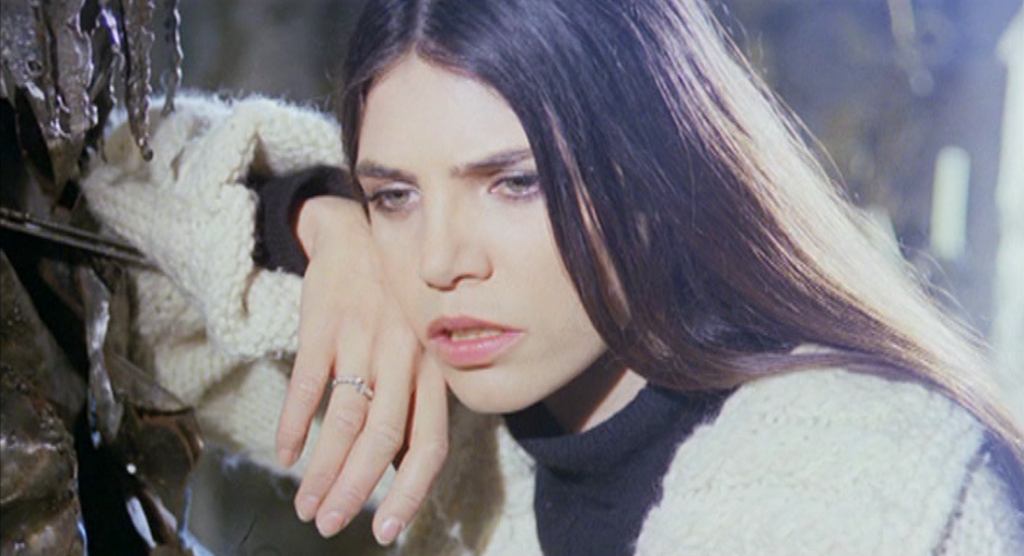
As soon as they get checked into their room, her sister Dagmar (Stafania D’Amario, Zombie, Nightmare City) peels off her dress, garters and hose as Ursula unpacks a picture frame. One thing I learned from this film is that girls in Europe need to change clothes every 10 minutes… this is just the first of many “dropped dress” scenes that usually result in simply another pair of clothes being shrugged on.
Maybe dry cleaning is free at the resort.
We get some gorgeous photography of a short stone wall and blue-lit stone castle walls before we then meet Stella Shining, the manager’s star nightclub performer whose songs entrance the guests, even in the off-season. I just had to wonder where her microphone was as she did it.
But Ursula is quickly a spoilsport and drags Dagmar away from a good time so that she can talk obliquely about her father’s blood.
And then… introductions concluded, we cut to the first of our series of black-gloved killer scenes when a prostitute invites someone back to her room to watch her and her lover have sex. Cue the sexy thumpa-thumpa saxophone riff.
When the prostitute asks after the skin has been well-shown to collect her fee from the voyeur, we get our first glimpse of black gloves and eyes behind a mask and… wait, is that the hint of a giant penis shadow? Is that really what I thought I saw?
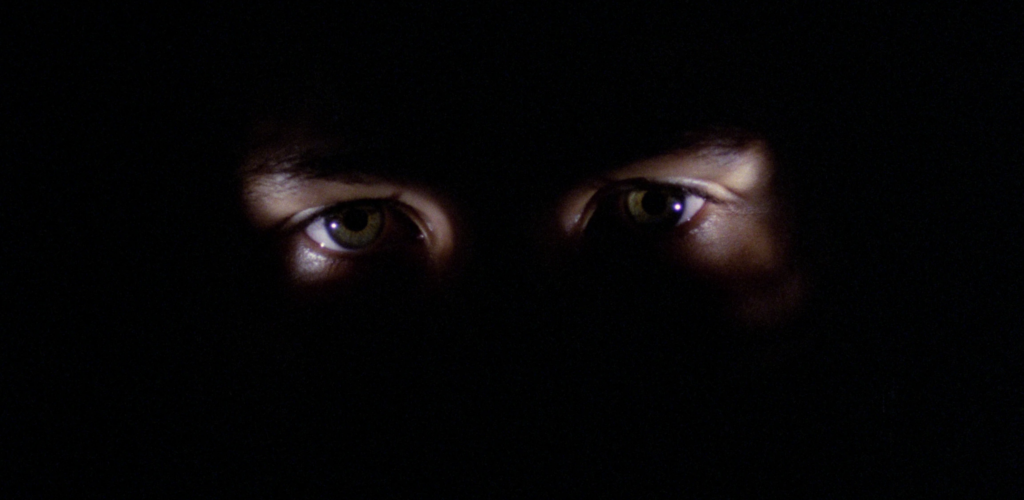
Dagmar gets sweet on Stella Shining’s junkie ex-boyfriend Filipo (Marc Porel, The Psychic) but Ursula implores her to abandon that pursuit, suggesting that she has hidden psychic powers that Dagmar (and we) should pay attention to. “It’s not my fault I can see things in others that they cannot see,” she says, and then warns, “I know that man will murder me, mark my words.”
Dagmar clearly doesn’t believe her sister and keeps chasing Stella Starlight’s boyfriend Fillipo, who shows interest in her yet keeps trying to get Stella to take him back after he reveals he’s a junkie and convinces her to get the hotel manager to help him get a fix.
And then… cut to two kids who the manager won’t let get a room in the hotel (scandal!) so they wander the grounds until they are in some underground stone lair filled with statues and other arty debris. What better place for youngsters to get it on?
Cue that sexy sax riff again. And… guess what.
There’s that enormous penis shadow again!!! Look out!
You get the gist. If you’re in the mood, this a silly, sex-drenched mystery that will have you wondering about the penis shadow as much as who the killer actually is. There is as much sex in here as any Skinimax film of old, from lesbian couplings to masturbation with a chain to the standard missionary bop which means… lots of that saxophone riff. But there’s blood too… that giant penis shadow is not kind.
Will Dagmar get her boytoy? Will Stella Starlight ever sing with a microphone? Will the junkie really murder Ursula? Will you ever see what’s behind that giant penis shadow? You’ll have to watch this to find out.
You might not guess the killer, because it is a little bit of a stretch given the way the murders occur but… you are given all the clues you need, really. The jaded will likely guess the end early.
I hadn’t watched my Shameless Films DVD edition of this in quite a few years, so I was pretty excited when Vinegar Syndrome recently released a remastered version on Blu Ray as part of the Forgotten Gialli Volume 4 box set. The upgrade looks phenomenal; when the sexy sax riff isn’t playing, there are some gorgeous beach and hotel and local village shots in this one. I wish I could go to that resort.

You can still get the Severin edition of this on Amazon but I’d hold out for the Vinegar Syndrome Forgotten Gialli 4 box set. This one gets a 3 for plot but a 9 for schlocky fun. Let’s call it a 6!

6 out of 10 black-gloved fingers!
FUN ASIDE: I am a huge fan of Suspiria and back in 2015, at Flashback Weekend in Chicago, Barbara Magnolfi, who had a small part in that film, had a booth across from my author booth all weekend. I talked to her a few times (not enough, really!) and got a signed picture from her. I should have talked to her about Ursula back then but… I have to admit, I didn’t. Still, I will always have this picture in my TV room!
NIGHT #17:
Strip Nude for Your Killer
Directed by Andrea Bianchi
Screenplay by Massimo Felisatti
Music by Berto Pisanoo
(1975)
Opening with a blue-tinted image of an abortion in progress that quickly goes south, it’s clear if you didn’t get it from the title that this murder mystery is going to be steeped in sexual overtones.
And it is.
By the mid-70s, there had been scores of gialli made, and directors kept upping the violence and sexual ante to try to keep luring viewers in. Strip Nude For Your Killer probably has the highest nudity quotient of any giallo, as it centers around fashion shoot models of the Albatross Studio who are being picked off one by one by a killer dressed all in black with an identity hidden by a motorcycle helmet. The killer stalks and slashes the throat of the illegal abortionist almost immediately after the opening credits.

Director Andrea Bianchi, who would go on to give us the racy Malabimba and perverse Burial Ground, doesn’t let 10 minutes go by without something salacious searing the camera. We get nude sauna scenes, provocative night club dancing, a brief power-trip lesbian scene, an obese studio owner who keeps a love nest to lure models to (even though he’s impotent), and giallo superstar Edwige Fenech showing off her ample assets as she tries to move from her role at the agency as a photographer to the one being photographed… Meanwhile, the body count mounts.
Why? And what does the snowflake-shaped earring have to do with it all?

Photographer Carlo (played by Nino Castelnuovo of Camille 2000) and Edwige’s character Magda are determined to find out, before they end up under the knife themselves.
Hideous 1970s green and gold daisy wallpaper mixed with wide-collar fashion and red vinyl couches and a soundtrack filled with cooing female “do do do” voices, organ swells and the urgent “something’s going to happen now” jazz-funk bassline only add to the fun of this sleazy, cheesy whodunnit.

Photographs, models, lights-suddenly-going-out and a leather-gloved killer check all the giallo formula boxes on this one and certainly nobody won any Oscars for their performances here, but if you like your thrillers packed with tease, this is 90 minutes that will keep you entertained. It’s serious sleazy popcorn fun.
You can catch this on disc from Blue Underground or Arrow or stream it on Amazon Prime.

7 out of 10 black-gloved fingers!
NIGHT #16:
Oasis of Fear / An Ideal Place to Kill
Directed by Umberto Lenzi
Screenplay by Lenzi, Lucia Drudi Demby, Antonio Altoviti
Music by Bruno Lauzi
(1971)
Oasis of Fear, also known as An Ideal Place to Kill and Dirty Pictures, is a different kind of giallo. It’s basically a three-character cat-and-mouse game and who, exactly, is the mouse is not always clear. Instead of a string of murders, our protagonists get embroiled in just one. But it’s a sticky one!
At the outset, veteran director Umberto Lenzi gives us a glimpse at two European free spirits, Dick and Ingrid, as they peddle “dirty pictures” throughout the city. It’s like the opening to the TV series “That Girl” as they cavort around the canals holding hands as an upbeat yet bittersweet 60s-ish pop song – “How Can You Live Your Life?” – plays (sung by lead actor Ray Lovelock).
The couple sell their pictures to people on the street and then spend all the money on food and parties, and then start the cycle all over again.
At one point, they go into an underground sex shop and buy things to resell… which was enlightening – who knew that before VHS, they used to sell vinyl record albums of the sounds of lovemaking? Not me!
In any case, when they run out of product again, Dick (Ray Lovelock of Almost Human) starts shooting nude pictures of Ingrid, (Ornelia Muti, who has a bit of a “Laurie Partridge” look going on here and would later star as Princess Aura in Flash Gordon).
But then they get arrested for peddling porn and have to flee the country. They hit the road, but run out of gas in the middle of nowhere, so they push their car to a nearby house where it appears that nobody is home.

But when Dick gets the idea to siphon gas from the car parked in the garage so that they can get back on the road… they’re discovered by the owner of the house – Barbara (played by Irene Papas of Zorba the Greek and Don’t Torture a Duckling fame).
At first, Barbara is cool to them, as they proclaim themselves “dedicated missionaries, bringing the gospel of sexual freedom to darkest Italy!” But soon she seems lured by their bacchanalian attitudes and invites them to stay for the night as her husband is away and not coming home. Drunken revelry ensues and a strange love triangle starts with Barbara seemingly playing both sides of the pair.

It’s all a lark until Dick discovers a gun in the glovebox of the car and later, money that he didn’t have in his pocket; a plot much darker than dirty pictures begins to emerge.
I won’t say any more because it’s a fun spiral to discover; and the ending? It’s a jaw dropper. Lenzi pulls no punches. If you like your murder mysteries a bit racy with a hippie free-love sheen, this is the movie you’ve been looking for!
You can still find copies of the Shameless Films DVD released as Oasis of Fear, which is what I own, but a couple years ago, Mondo Macabro released an upgraded blu-ray edition under the An Ideal Place to Kill title.

7 out of 10 black-gloved fingers!
I started the first week of these 21 Nights with the giallo master Dario Argento… so I thought we should start the final week with him as well:
NIGHT #15:
Trauma
Directed by Dario Argento
Story by Argento, Franco Ferrini and Gianni Romoli
Screenplay by T.E.D. Klein
Music by Pino Donaggio
(1993)
Trauma was Dario Argento’s “coming to America” movie. It was his first solo film since 1987’s Opera, after his anthology film with George Romero, 1990’s Two Evil Eyes. He enlisted Phenomena and Demons screenwriter Franco Ferrini to devise the story, but since the film was to be set in America (Minneapolis), he brought in horror novelist T.E.D. Klein to script. He also cast his teen daughter Asia Argento in her first starring role.
The film follows Asia’s character Aura, an anorexic escaped from a psychiatric hospital, and David Parsons (Christopher Rydell from For The Boys), who works at the local paper, in trying to find the Headhunter killer, who murders Aura’s parents as part of a string of beheadings.
The film opens with a woman being visited by a medical patient on a rainy night, only to be decapitated by a strange contraption that is basically a small motor that constricts a loop of wire. (The device was fashioned by American effects guru and occasional actor Tom Savini). It’s a good creepy opening that of course begs the question we’ll spend the next hour and a half trying to answer – who’s the killer and… why?
David then meets Aura, who he saves from jumping off the Hennepin Ave. bridge with the backdrop of Minneapolis behind them. We quickly learn that she is a teen junkie and anorexic on the run, but when she ducks away from David, she’s quickly picked up by the authorities and delivered back to her parents, who plan to recommit her to the asylum where she is being cured of her condition.
But first… a séance!
Aura’s mother, Adriana (Piper Laurie), is a medium and has several people over that night for a séance. In the midst of a dark, rainy, thundering night… the lights all go out and Adriana disappears. When Aura and her father go out to search for her amid the trees and rain, he is killed and Aura finds his headless body and sees the killer on a small hill, holding the head (very Headless Horseman here!)

Aura ends up taking refuge with David, but when she stumbles on him making love to his girlfriend, she gets jealous and runs away again. Once he catches her, we know that this is no longer a platonic affection; despite the age difference, these two are a couple. And they are a couple determined to find the killer.
Meanwhile, there are some fun scenes with a young bespeckled boy who chases a gecko into the window of the house next door. This is a setup that seems far more suited to a Mediterranean locale than Minneapolis, but… whatever! The dialogue-less scene with him discovering the garrote of the Headhunter and barely making it back out the window is one of the best, most suspenseful parts of the film.
I won’t give away any more of the plot since it’s worth discovering fresh, but suffice it to say that Aura and David go on quite the emotional rollercoaster as the head count stacks up.
Critics have railed at the film calling Asia’s performance amateur and Chris Rydell and Piper Laurie’s over-the top. I actually enjoyed all of them; the places where I think the film has issues have more to do with ridiculous effects (heads’ lips still moving after being severed) and the general blah-ness of the location. Argento was trying, clearly, to make a more modern, Americanized thriller. But setting – the gorgeous old buildings and parks of Europe – has always imbued his work with a richness that grungy suburban America can’t fulfill.
Add to that the fact that Argento had learned of a new “hot thing” way of creating atmosphere in film – a smoke machine. Rather than using lens filters, by pumping a light smoke across all of the sets, all of the camera work looks soft. It’s a touch of noir style, but the greyness it imbues is a far cry from his usual extreme mixes of color. And in one scene, where David’s girlfriend is lying posed on the bed, the impact of the smoky air behind her makes the film look like a late night ‘90s “Skinimax” feature for a minute.
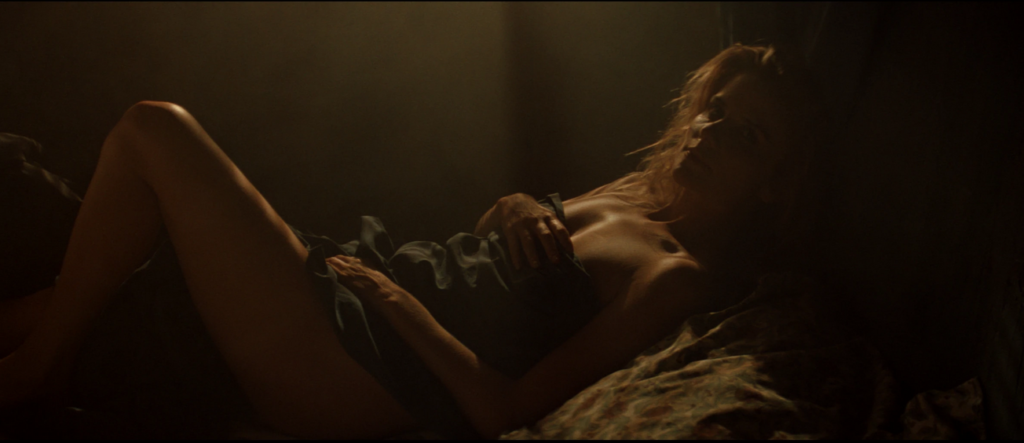
The fad ultimately hurt him – Argento became sick from the smoke and lost his sense of smell for months.
There is still some evocative cinematography here; there’s a hospital scene where the psychiatric inmates behave almost like zombies, there’s a “heads in the trunk” reveal that is delightfully grue-ish, and there are some (not enough) beautifully framed settings. In one scene, as a car pulls up to the woodsy cabin David lives in, the sky and trees and oval drive are an absolutely gorgeous frame. And in one shot, the red light in the cabin shifts to an almost electric blue moon with clouds running over it. So the suburban setting didn’t force the film to be all grey.
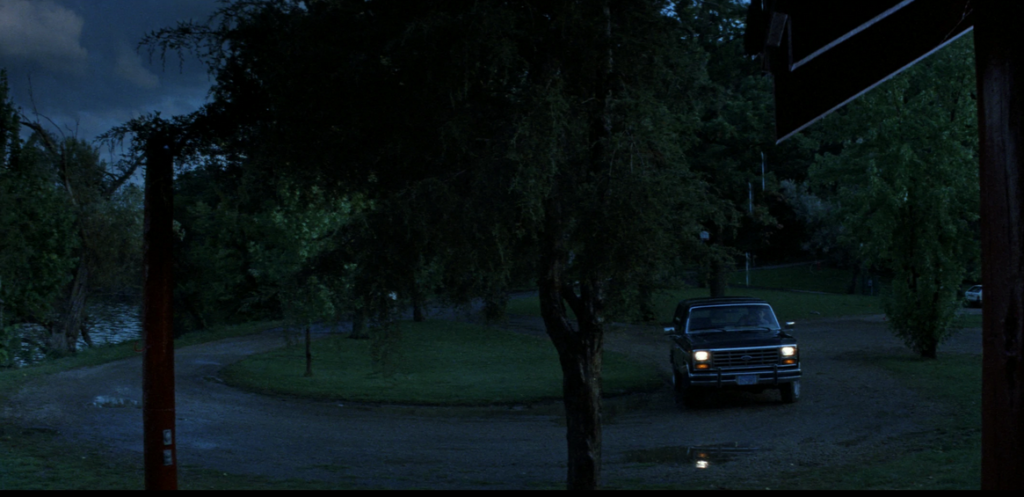
The old mansion where Aura used to live also has some nice classic wood appointments and some nice sweeping camera work dives through the halls. Late in the film, there’s a scene where David has to walk through sheets all emblazoned with the words Nicholas on them as a creepy voice repeats the name; it’s evocative of Suspiria moments, if not quite as effective.
Pino Donaggio, of Brian DePalma fame, provides the orchestral soundtrack, which definitely makes this feel like a more Hollywood production… but that’s also a negative; an orchestral score doesn’t offer the same level of tension and creepiness that Goblin’s electronic scores gave so many other Argento productions. There is, however, a gorgeous theme song in the ethereal female vocalized “Ruby Rain” which is worth adding to your playlist.
In the end, I enjoy Trauma for what it is – a ‘90s thriller. It’s easy to complain about what it’s not – it’s not Argento’s work of the ‘70s. But… to be fair… it couldn’t be. Those days were gone. The world had moved on.
Sometimes the Italian-American cross pollination works here, and sometimes it feels a little mismatched. This isn’t really a spooky Italian thriller but it’s not really an American thriller either. But I enjoyed the “love story” angle (Argento’s first!) and the identity and motive of the killer is a strange, disturbing reveal that harks back to his mid-‘70s work. The role of the young boy in the conclusion will also make you squirm for a minute.
I wouldn’t watch this first or even fifth in the Argento catalog… but I would recommend seeing it. You can get a nice new 4k scan of it on Blu-Ray from Vinegar Syndrome.








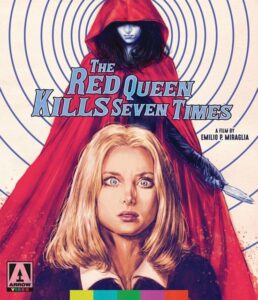




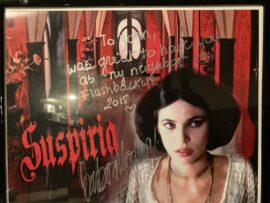








Pingback: 21 Nights of Giallo: Week One ~ John Everson
Pingback: 21 Nights of Giallo: Week Two ~ John Everson